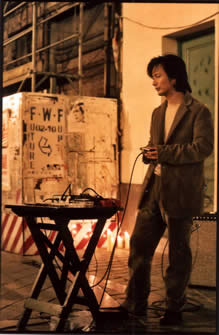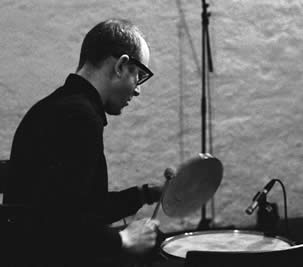Send + Receive: A Festival of Sound [version 8]
Independent / Freelance Writer
Article by Deanna Radford from Once Upon A Poolside, Poolside 2005, edited by Bev Pike, launched January 14, 2006. Published by Video Pool Media Arts Centre, Winnipeg, MB. Special thanks to Video Pool Media Arts Centre for permission to reprint this piece.
EACH YEAR, the Send + Receive Programming Committee reviews dozens upon dozens of submissions to select for the upcoming festival. It is this intense time of review that often reveals connections, and allows for overarching festival themes to evolve. As the Programming Committee came closer and closer to selecting the final roster of participating artists for 2005, it seemed as if analogue, as opposed to primarily digital approaches to the creation of sound and media art, were prevailing. While this remained only partly so, Send + Receive 2005 nonetheless encompasses a unique collection of tools used by the featured artists. Importantly, the artists involved with [version 8] saw to an expansion of boundaries...of sound, performance, poetry and cinema that, as Programming Committee member Tom Kohut puts it, “re-collected and re-connected” all of our senses and memories, creating new hybrid environments to explore. Indeed, this is something that Send + Receive continually strives for, and presents,each year. Here are two international artists who help make this happen in 2005.
Interview: Aki Onda

Working to create and foster an environment built upon personal and public sonic memory, Brooklyn resident Aki Onda is an illusionist, a conjuror. With his major work Cassette Memories, Onda is well aware of the sensual and evocative powers that sound holds. Onda works to ensconce the viewer, the participant, into a sentient space comprised of his diaristic cassette recordings, collected over many years and extensive travels. Nearing epic proportions in performance time, the four-hour-long work breaks down, and warms up, the notion of typical performer/audience dynamics. Or, more accurately, the work interrogates contemporary electronic music and sound performance. With long-burning bee’s wax candles adorning the performance space, the Cassette Memories performance blends ideas of shape, configuration, narrative and experience into something that is sensually tactile, shimmering and elusive. What follows are Onda’s responses to questions about his particular use of narrative.
I used to use narrative structure when I made music. If you listen to my albums, such as Un Petit Tour or Precious Moments, it’s easy to recognize it. I was interested in creating musical environments more than composing pieces at that time. I applied filmmaking methods to music making, and called it “radio drama.” However, my main project that I am engaged in, Cassette Memories, is different. It’s much closer to music and I compose pieces in a musical way.
The influence of musique concrète is especially apparent. Pierre Schaeffer, Luc Ferrari, Françoise Bayle…French electro-acoustic music is one of the roots. Also, hip hop dJs [from] the 80s and turntable players such as Christian Marclay, DJ Olive, Toshio Kajiwara... their methods inspired me a lot when I developed my performing style by using cassettes. Tapes, vinyl records, they are all magnetic sounds. So what I make is magnetic machine music.
Everything I make [has] something to do with memory. I do field recording or take photos, like writing a diary. I am documenting fragments of my personal life, and something is revealed in their accumulation.
I want to create space that conjures up the general essence of memory.
“I have continued to be inspired by the work of people such as Jonas Mekas, Peter Beard, Robert Frank, Phill Niblock, Luc Ferrari. These are all people who have obsessed over the mechanism of the human capacity for memory. And then people like Jon Appleton, sft (Simon Fisher Turner), Toshio Kajiwara and dj Olive have lent me concrete opportunities for grasping at this <certain state of musicality>. The music that I make exists in the expanse of music shaped by the memories of many people.” August 2002, New York, Aki Onda (from http://www.japanimprov.com/aonda)
It depends on how you see my work… It could be a story telling or portrait painting. Or could be both at the same time.
Interview: Jason Kahn

Originally a percussionist, Zürich-based US expatriate Jason Kahn spent many years honing his craft as a musician in punk rock bands (his band The Leaving Trains recorded for the venerable sst label), and by studying all varieties of percussion in the u.s., London and Paris. Kahn explains that he “later began to incorporate live electronics into his playing, currently performing using laptop, analogue synthesizer, or combining these with percussion.” Kahn has a dynamic career as a creator, sound artist and improviser, having worked with Evan Parker, Christian Marclay, Steve Roden, Send + Receive alumnus Otomo Yoshihide, Sachiko M. and others. Jason Kahn runs the CD label cut, has performed worldwide and composed works for dance and theatre. For Send + Receive, Kahn gives a live performance, as well as a workshop on small sound composition and recording, and an installation, Glengarry Block Stairwell.
[DEANNA RADFORD] Does the element of narrative, however abstract that might be, ever come into the picture for you when you are creating a sound piece? When you perform?
[JASON KAHN] In both cases here — performance and sound pieces (installation, radio, internet, etc.) — narrative doesn’t really play a role. I see myself as creating an environment for the listener to enter. I am very inspired by environmental sound and try to view my performative and composed work in the context of this: this is to say, sound without narrative, without impetus. I don’t want to tell a story, rather, create a place.
[DR] You strive to create a sense of atmosphere with your work. Should your approach be more poetic than technical, does your approach change depending on what medium you’re working within (performance, installation, radio works)? What might be some of your favourite ways to work towards this?
[JK] Whatever is technical for me in my work is there only by necessity. I’m not really very interested in the technical component, beyond the fact that it allows me to convey my ideas. I’m also not sure if I could term my work “poetic” (in the sense that I understand this term). I really try to think of my work as if I were walking down the street and heard an inspiring juxtaposition of different sounds. I wouldn’t say “Ahh, the sound of the wind blowing through the leaves of that tree is poetic.” Perhaps beautiful, but not poetic.
I try to keep the same approach, or rather the same sensibility, whether I am performing or creating a sound work. Of course, I know very well that when a room full of people is listening to me I cannot create in the same way as when sitting at home in front of the computer. But this is my intent and my starting point.
Above all, I want the technological aspect of my work, whether an installation or a performance, to be transparent: I don’t want people to concentrate on how the work is made, rather, just the sound.
[DR] You work with and create small sounds. This contributes to a certain way an active listener must partake. With this in mind, might you view this as a political act or political way of establishing voice… creation of space?
[JK] I wouldn’t claim my work to be political, as the concept of politics seems to change from person to person. I would say, however, that my work has a social component in that I am interested in people taking the time to actively listen to the sounds around them. Placed in the context of western industrialized societies, where the average person is continuously bombarded with sound and image, the mere of idea of stopping and listening could be viewed as a way of people re-discovering the environment or even an aspect of oneself, which has been thwarted by years of sensory saturation.
Beyond the idea of listening, is the factor of time. So many of us today live under constant time pressure and the pace of daily life is constantly accelerating. My work needs time and attention to reveal itself. It is not for people in a hurry.
The other night I performed here in Zürich. My neighbour came to listen. She has no context for what I am doing, but after the performance she told me how nice it was to just listen and that she hadn’t done this for such a long time. And this basically sums up what I am trying to do.
[DR] How might this intermingle with your background as an improvising musician and the performer/audience
dynamic?
[JK] In terms of my activities as an improvising musician, my work with environmental sound and sound installations has had a direct impact on how I perform and collaborate with other musicians. I like to think of the music as something without a beginning or end (of course, I know that, strictly speaking, this isn’t true), and I am somewhere in the middle of the course of sound events. This is to say: I want to let the sound envelop me and develop of its own accord. Of course, the musicians are guiding the music but my intent is to move away from gesture, from drama, from narrative, from meaning.
Aki Onda http://www.japanimprov.com/aonda.
Jason Kahn http://www.jasonkahn.net
Poolside http://videopool.typepad.com/poolside
Send + Receive http://www.sendandreceive.org and http://www.myspace.com/sendandreceive.
Both Jason Kahn and Aki Onda will be performing at this year’s edition of the Festival international de musique actuelle de Victoriaville in Québec, May 17–21. Send + Receive: A Festival of Sound version 9 takes place in Winnipeg, Manitoba from May 8–13.

Other Articles by the Author
“Between Sounds and Abstractions — Response to Catherine Béchard and Sabin Hudon’s (Québec) acoustic work of same name.” Critical Distance Vol. 11/2 (Winter 2006). aceartinc.
“Send + Receive: A Festival of Sound [version 8].” Review in Once Upon A Poolside, Poolside 2005 (Winnipeg: Video Pool Media Arts Centre, January 2006), pp. 51–57.
Video Pool Media Arts Centre annual media arts anthology, Once Upon A Poolside: Send + Receive: A Festival of Sound artist profile, January 2006
“Christof Migone — Sound Voice Perform.” Book review, Musicworks magazine #93 (Fall 2005).
“High-quality High-tech: MUTEK — Music, Sound and New Technologies.” Festival review, Musicworks magazine #93 (Fall 2005).
“Unraveling Sound Cultures.” Book review of Audio Culture: Readings in Modern Music (Christoph Cox and Daniel Warner, eds.). Musicworks magazine #92 (Summer 2005).
Online
“Sound Out — On the Prairies.” Composer activities summary in eContact! 9.2 — Canadian Regions: The Prairies (March 2007). Canadian Electroacoustic Community.
Social top